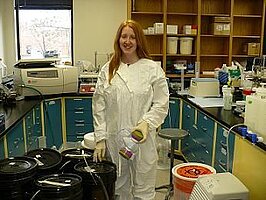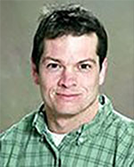Source tracking of Cryptosporidium in rural watersheds

Brianna Schneck is a graduate student (PhD) in the Environmental and Conservation Sciences (ECS) program and NDSU. She completed her B.S. in zoology (emphasis in fisheries, wildlife, ecology, and behavior) from NDSU in May of 2008. Brianna’s main research focuses on understanding Cryptosporidium adaptation and coevolution with host species and applying that knowledge to source tracking in rural watersheds.
Brianna.L.Schneck@ndsu.edu
Fellow: Brianna Schneck
Co-Advisors: Dr. John McEvoy, Department of Veterinary and Microbiological Sciences
Dr. Mark Clark, Department of Biological Sciences
Degree Progress: Ph.D. in Environmental and Conservation Sciences expected graduation 2013.
Source tracking of Cryptosporidium in rural watersheds
The Upper Midwest has among the highest incidences of human cryptosporidiosis in the U.S. (Hlavsa et al. 2005). There is therefore a critical need to determine Cryptosporidium sources and transmission dynamics in this region. A study, which I co-authored, has shown that most human cryptosporidiosis in the region is caused by C. parvum, a species associated with humans and cattle (Feltus et al. 2006). However, the traditional model, describing Cryptosporidium movement from livestock to humans via water, appears over simplistic in light of recent evidence of wildlife sources of contamination. To better understand the human health significance of Cryptosporidium in rural watersheds, we need to determine the source of the contamination. I will address this need by quantifying the impact of the wildlife and cattle sources in rural watersheds in the region. With the successful completion of this project, I expect to have clarified the public health significance of waterborne Cryptosporidium in rural watersheds. Outputs from this project will have regional, national, and international relevance and will be critical to the guidance of future policies on the control of Cryptosporidium transmission in water.
The present research is in continuation of the work proposed for the 2009 NDWRRI program.
Project Objectives:
To determine the factors influencing the contributions of cattle and wildlife to Cryptosporidium in rivers. This is critical to understand the public health significance of Cryptosporidium in rural watersheds.
Progress:
Empirical evidence supports host adaptation and a limited host range for most Cryptosporidium species and genotypes. This knowledge has been used to track sources of water contamination and characterize human health risk; however, the factors affecting host range remain unclear. We are using small mammals (mainly rodent species) as a model to study the effect of factors such as host population density, diversity and behavior on the host range of Cryptosporidium genotypes. Over 250 wildlife fecal samples (from rodent species) have been collected and analyzed over the past year. Trapping grids were set up in various locations near water sources including rivers, streams, and drainage ditches. Cryptosporidium species/genotypes were found in over 40% of the samples. We found that red squirrels, grey squirrels, fox squirrels, and deer mice can carry Cryptosporidium cervine genotype which has been known to affect humans. Deer mice were also found to carry C. parvum, a known human pathogen. Rodents may be a significant source of Cryptosporidium in watersheds.
We found a high prevalence of Cryptosporidium species in water samples collected during the major flooding event that affected the Red River Valley in 2009. Nine out of thirteen water samples tested positive for Cryptosporidium. A cattle adapted species, Cryptosporidium andersoni, was found in seven of the nine samples. Cryptosporidium deer mouse III genotype was found in a sample taken from a drainage ditch. We also found DM III in grey squirrels and deer mice. Cryptosporidium suis, a pig adapted species, was also found in a water sample. Livestock contributed significantly to Cryptosporidium contamination in the Red River during a major spring flood.
Significance:
We expect to find that the prevalence of different wildlife and cattle associated Cryptosporidium species will be dependent on host abundance, prevalence of the parasite in the host population, and the number of oocysts being shed. As host numbers and parasite shedding rates fluctuate throughout the year, we expect to observe corresponding changes in the numbers and prevalence of Cryptosporidium in river samples. Results will be used to predict when different host species are likely to be significant sources of surface water contamination. For example, deer are known to herd more in the fall months and this may correlate with an increased environmental load of deer associated cryptosporidia and a corresponding increase in water prevalence. Understanding the dynamics of wildlife and cattle associated cryptosporidia in a watershed is critical to any assessment of health significance.
In March 2009, the Red River in Fargo, ND experienced its worst flooding in recorded history. Flooding of the Red River follows winter snow melt; however, on this occasion the river attained a record crest more than 7 m above flood stage. Our goal was to determine the prevalence of Cryptosporidium in the Red River and its tributaries during peak flooding. Fourteen 20-L water samples were collected from the Red River and five large tributaries (Buffalo, Maple, Rush, Sheyenne and Wild Rice Rivers). Samples were processed in accordance with EPA Method 1622. DNA was extracted from IMS purified oocysts and a fragment of the18S rRNA gene was amplified, cloned, and sequenced. Sequences were aligned and compared with the non-redundant Genbank database to determine the species/genotype of Cryptosporidium present. Nine out of fourteen (64%) water samples tested positive for Cryptosporidium with Cryptosporidium andersoni and the deer mouse genotype III identified in 7/9 and 1/9 samples, respectively. These data suggest that cattle were a significant source of water contamination during this major spring flooding event.
Publications:
Pennil, C.C., Clark M.E., Giddings C.W., Schneck B.L., and McEvoy J.M. 2009. Determining sources of Cryptosporidium in a rural watershed. Master’s Thesis (Chapter 2), North Dakota State University, Fargo, North Dakota, Chapter 2.
Conference/Seminar Presentations:
Schneck, B.L., Pennil, C.C., Lanctot, V.T., Giddings, C.W., Clark, M.E., and McEvoy, J.M. 2009 “Cryptosporidium genotypes in Midwestern mammals” Poster presented at III International Giardia and Cryptosporidium Conference, Orvieto, Italy, Oct.11-15, 2009.
Pennil, C. C., Clark, M.E., Schneck, B.L., Giddings, C.W., and McEvoy, J.M. 2009. “High prevalence of Cryptosporidium andersoni in surface water during a major spring flooding event” Poster presented at III International Giardia and Cryptosporidium Conference, Orvieto, Italy, Oct.11-15, 2009.
Pennil, C. C., Clark, M.E., Schneck, B.L., Giddings, C.W., and McEvoy, J.M. Department of Veterinary and Microbiological Sciences, North Dakota State University, Fargo, ND, USA Department of Biological Sciences, North Dakota State University, Fargo, ND, USA

John McEvoy
AES Microbiological Sciences
Office: VanEs 132A
Telephone: 701-231-8530
Email: john.mcevoy@ndsu.edu

Mark Clark
Biological Sciences
Office: Stevens 119
Telephone: 701-231-8246
Email: m.e.clark@ndus.edu


